The Timeless Power of Words
Matsuo Bashō — when we hear this name, many of us can recall at least one or two of his poems.
Why do his haiku continue to captivate hearts even centuries later?
Bashō’s haiku are not merely fixed-form verses of 5-7-5 syllables.
They are an art form that pares language down to its essence, condensing scenery and emotion into a single moment. Within them resides the very soul of the poet.
Haiku generates beauty through what it omits.
By stripping away excess explanation and leaving space, it invites the reader’s imagination.
Bashō’s poems seep deeply into the heart, like a single drop of water falling into stillness.
Even after more than 300 years, his words gently stir our sensibilities.
Loneliness and Beauty in the Life of a Traveler
Bashō’s life was inseparable from travel.
He never sought a place of rest, instead continuing his journey in search of ever-new landscapes.
The many famous poems born during these travels reflect a beauty that resides in solitude.
「夏草や兵どもが夢の跡」 ―― the summer grasses: the remains of warriors’ dreams
This haiku was composed during his journey recounted in The Narrow Road to the Deep North, upon his visit to Hiraizumi in present-day Iwate Prefecture.
Once, Hiraizumi was a splendid capital built by the Ōshū Fujiwara clan.
In the 12th century, it rivaled Kyoto in cultural richness and prosperity.
Chūson-ji Temple with its golden hall, the Pure Land gardens of Mōtsū-ji designed to replicate paradise on earth—this place embodied the height of beauty and culture in medieval Japan.
Yet that grandeur vanished within merely three generations, disappearing like a dream.
Bashō visited this site approximately 500 years later.
What lay before him then was a quiet field, where only the summer grasses swayed in the breeze.
Perhaps in that view, he saw the dreams and ambitions of the warriors who once flourished—and the silence that followed their fall.
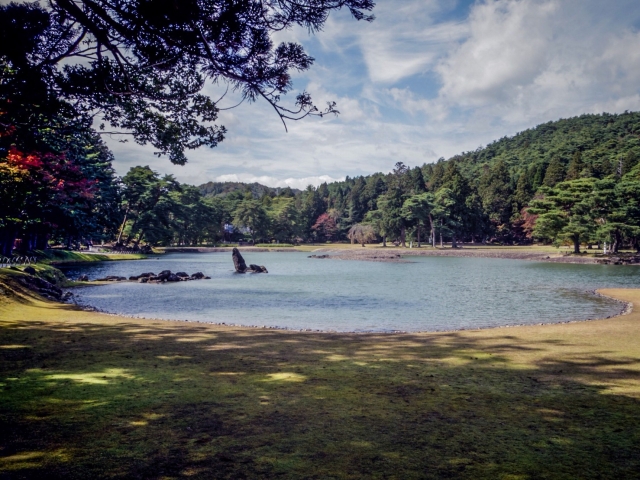
Mōtsū-ji — All the buildings have been lost, and only the garden remains today.
”the summer grasses: the remains of warriors’ dreams”— This haiku presents a stark contrast between the “dreams of warriors” and the now-silent field of overgrown grasses.
That contrast starkly reveals the cruelty of time and the transience of human endeavors.
This awareness of impermanence gently, yet unforgettably, settles into the soul like a passing breeze.
Bashō’s haiku are never flashy.
Rather, they gaze tenderly upon what has passed or is vanishing, and this gives his verses their profound depth and quiet poignancy.
Today, Hiraizumi is recognized as a UNESCO World Heritage Site, attracting visitors from around the world.
Yet the silent stories that dwell in its stillness are likely unchanged from that summer day seen by Bashō.
The Echo in Silence — A Summer Moment Seen by Bashō
On his journey through The Narrow Road to the Deep North, Bashō visited Yamadera (Risshaku-ji) in Yamagata Prefecture.
Over a thousand stone steps, temple buildings clinging to the cliffs, and nothing but the sound of cicadas echoing in the heat—this sacred place of summer stillness offered Bashō a moment approaching the eternal.
This haiku encapsulates not just the scenery but the entirety of the sensation experienced in that place.
The opening word “閑さや” conveys not mere silence, but a deep quiet that resonates within the soul.
After climbing the stone steps and facing the majesty of nature, one feels a hush in which even time seems to stop.
The unceasing chorus of cicadas seems to melt into the air of midsummer at Yamadera.
Yet it is not a harsh or noisy sound—it resonates as if soaking into the very rocks, merging into the environment.
A strange sensation of sound becoming one with silence—this might be a feeling one can only truly understand by standing in that place oneself.
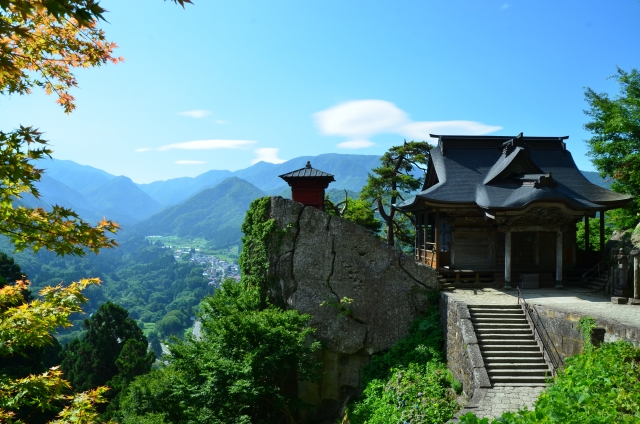
Yamadera (Risshaku-ji) in Yamagata Prefecture
In fact, the author of this piece once visited Yamadera on a summer day.
Amid lush greenery and moss-covered steps, the cicadas’ calls layered faintly from a distance.
Then suddenly, all other sound seemed to vanish, and it truly felt as if the cicadas’ voices were sinking into the rocks.
The voice of the short-lived cicada permeates ancient stone, and Bashō himself, sensing that voice, also seems to dissolve into nature—
This single haiku captures Bashō standing between impermanence and eternity.
Even now, over 300 years later, that moment quietly descends into the hearts of those who visit the same site.
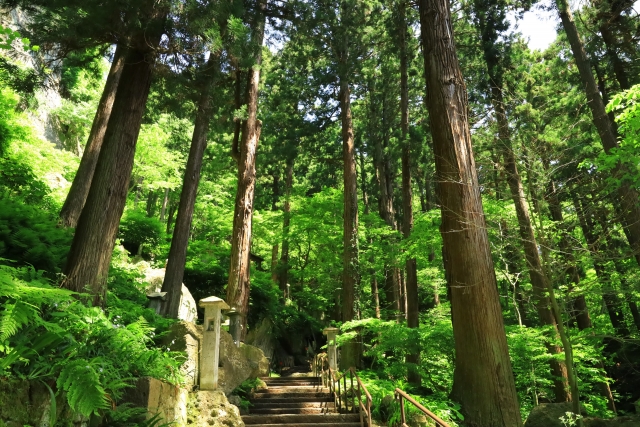
Along the mountain trail of Risshaku-ji, Bashō found inspiration for his haiku in the surrounding landscape.
The Eternal Beauty of “Fueki Ryūkō”
In his lifelong pursuit of haikai, Bashō left behind the phrase fueki ryūkō—“the unchanging and the ever-changing.”
Fueki refers to the immutable essence:
the beauty of nature, the transitions of the seasons, the subtleties of human emotion—universal truths that transcend time.
Ryūkō, on the other hand, denotes novelty that flows with the times:
the ability to embrace change and create new expression.
Bashō said:
不易を知らざれば基立ちがたく、流行を知らざれば風新たならず
(If one does not understand the unchanging, the foundation cannot be established.
If one does not understand the changing, new style cannot arise.)
Without knowledge of the past, one cannot build a true base;
without awareness of the new, one cannot move or inspire.
Bashō’s poetry stands precisely upon the balance of these two forces.
What he sought was a beauty that transcends technique and trend—an eternal beauty.
To find it, he wandered ceaselessly, conversed with nature, and refined his words with utmost care.
His stance became a guiding light for generations of poets, and fueki ryūkō remains a core principle of haiku to this day.
Why Do Bashō’s Haiku Resonate So Deeply?
Why do Bashō’s haiku still touch the hearts of people more than 300 years after they were written?
Because his words grasp universal truths that transcend time and borders.
The beauty of nature. The transience of life. The subtle presence felt in silence—
These are things that remain precious to us even now.
In an age overwhelmed with information and overflowing words,
perhaps it is Bashō’s “seventeen syllables of silence” that offer us a moment of peace.
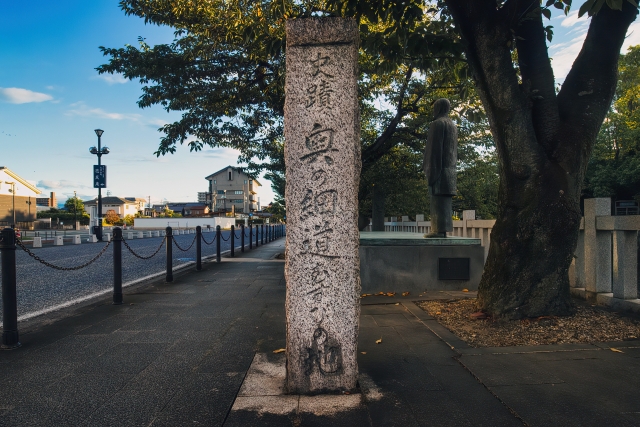
Historic monument marking the end of Bashō’s ‘Oku no Hosomichi’ journey (Ōgaki City, Gifu Prefecture)
Each time we read Bashō’s haiku, a new landscape reveals itself.
They are not mere descriptions, but invitations to sharpen our senses,
to ask ourselves how we see the world.
Haiku reflects the invisible and lets us sense the inaudible—it is the pinnacle of poetry.
Every word left behind by Matsuo Bashō continues to quietly warm our hearts,
like a flame that burns softly but eternally.

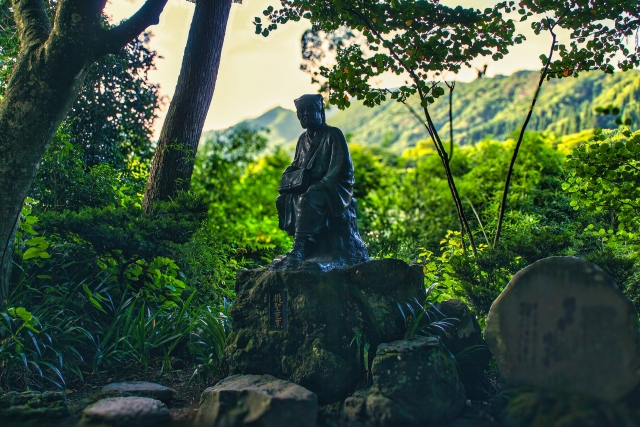


コメント